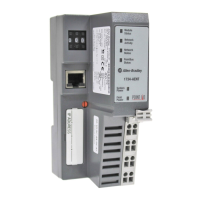
Do you have a question about the Allen-Bradley Rockwell Automation 1734-AENT and is the answer not in the manual?
| Model | 1734-AENT |
|---|---|
| Category | Network Hardware |
| Type | EtherNet/IP Adapter |
| Ethernet Ports | 2 |
| IP Addressing | Static or DHCP |
| Network Address | Configurable via software |
| Mounting | DIN rail |
| Number of Ports | 2 |
| Port Type | RJ45 |
| Communication Protocol | EtherNet/IP |
| Manufacturer | Rockwell Automation |
| Power Supply | 24V DC |
| Enclosure | Open-style |
Outlines the manual's preface content and structure.
Identifies the intended audience for the user manual.
Explains conventions used throughout the manual for clarity.
Summarizes updates and new content in the current manual version.
Explains the use of change bars to mark revisions in the document.
Provides an overview of the adapter and its features.
Highlights crucial points to note before using the adapter.
Details the process for configuring the adapter's chassis size.
Explains procedures and considerations for replacing an adapter.
Addresses scenarios involving empty slots and modules removed under power.
Guides on initial power-up procedures for the POINT I/O system.
Lists the key features and capabilities of the 1734-AENT adapter.
Specifies compatible firmware revisions and software versions.
Describes the primary functions performed by the 1734-AENT adapter.
Explains the role of the Common Industrial Protocol (CIP) in the adapter.
Details the producer/consumer networking model used by CIP.
Explains how to specify the RPI for data update rates.
Discusses the adapter's support for different connection types.
Covers the ability to combine rack-optimized and direct connections.
Provides preliminary considerations before starting adapter setup.
Outlines the topics covered in the adapter installation chapter.
Helps identify the external features and parts of the adapter.
Provides steps for mounting the adapter onto a DIN rail.
Guides on how to mount or replace the adapter in an existing setup.
Details the wiring procedures for the adapter.
Provides the physical dimensions for adapter mounting.
Introduces the chapter on configuring the adapter for EtherNet/IP.
Outlines the necessary IP address, subnet mask, and gateway settings.
Explains the concept and structure of IP addresses for network nodes.
Describes the function of a gateway address in network communication.
Details the use of subnet masks for network segmentation.
Covers methods for setting the adapter's network IP address.
Guides on using the BootP/DHCP utility for IP address configuration.
Instructions on how to save the BootP/DHCP relation list for future use.
Explains how to use DHCP software for adapter IP configuration.
Outlines the chapter on configuring the adapter using RSLogix 5000.
Describes the hardware setup for the example application.
Steps to create a sample application project in RSLogix 5000.
Guides on configuring the I/O modules within the controller.
Process for adding the EtherNet/IP bridge module to I/O config.
Steps to add the 1734-AENT adapter to the I/O configuration.
Adding POINT I/O modules to the adapter's configuration.
Procedure for adding a relay output module to the configuration.
Procedure for adding a digital output module to the configuration.
How to edit controller tags for use in the application program.
Steps to create a ladder logic program for testing I/O.
Instructions for downloading the application program to the controller.
How to verify and set the module chassis size in the configuration.
Steps to assign a fixed IP address to the adapter for reliable communication.
Guidance on handling adapter overload conditions and potential fixes.
Introduces configuring the adapter for direct and rack-optimized modes.
Describes the hardware setup for the example configuration.
Steps to create a sample application project in RSLogix 5000.
Guides on configuring I/O modules for direct and rack-optimized modes.
Process for adding the EtherNet/IP bridge module to I/O config.
Steps to add the 1734-AENT adapter to the I/O configuration.
Adding a module and configuring it for a direct connection.
Adding a module and configuring it for rack-optimized communication.
Instructions for downloading the application program to the controller.
How to verify and set the module chassis size in the configuration.
How to use controller tags to access adapter and module data.
Introduces the chapter on understanding adapter LED status indicators.
Explains the meaning of different LED indications and their causes.
Introduces the appendix covering adapter web page diagnostics.
How to access and use the adapter's diagnostic Home page.
Guides on using various diagnostic pages for system analysis.
Guides on accessing and modifying adapter configuration settings.
Scanning the system to identify connected modules and their status.
Introduces the appendix for configuring the RSLinx communication driver.
Step-by-step guide for installing the RSLinx software.
Detailed instructions for configuring the RSLinx EtherNet/IP driver.
Introduces the appendix covering tag references for I/O modules.
Lists catalog numbers for various 1734 POINT I/O modules.
Details valid number ranges for data types used in RSLogix 5000.
Tag reference for 2-point digital input modules.
Tag reference for 4-point digital input modules.
Tag reference for 2-point digital output modules without diagnostics.
Tag reference for 2-point digital output modules with diagnostics.
Tag reference for 2-point digital output modules with overload diagnostics.
Tag reference for 4-point digital output modules with diagnostics.
Tag reference for 4-point digital output modules with overload diagnostics.
Tag reference for 2-channel analog input modules.
Tag reference for 2-channel analog voltage input modules.
Tag reference for 2-channel RTD input modules.
Tag reference for isolated 2-channel thermocouple input modules.
Tag reference for 2-channel analog current output modules.
Tag reference for 2-channel analog voltage output modules.
Tag reference information for specialty I/O modules.
Introduces the quick start guide for adapter and controller setup.
Steps to configure the 1734-AENT adapter properties.
Detailed procedure for entering adapter properties in RSLogix.
How to add additional POINT I/O modules to the adapter.
Guides on configuring POINT I/O modules using Controller Tags.
Steps to configure an Ethernet driver within RSLinx software.
Instructions for starting and using the RSLinx application.
Detailed steps for adding the AB_ETHIP-1 driver in RSLinx.